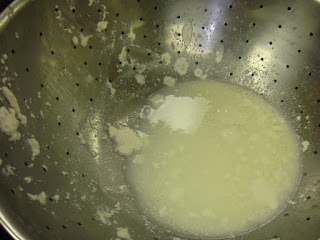 Waiting for the correct temperature to add the rennet
Waiting for the correct temperature to add the rennetFriday's mozzarella experiment with Emma's Keepers club friends proved that pasteurized milk from the grocery store yields inconsistent results. Three out of five of them produced soft, loose curds that would not hold together. Whether this was because the protein structure was destroyed in the pasteurization process, I can't say. Two girls used the same brand of milk with totally different results. One produced the best cheese in the class; the other ended up with cheese spread.
The girls had a lot of fun, no matter what the results of their cheesemaking. Two of the girls with curd failure were able to remove the excess whey, salt the curds, and spread it on crackers. They said it tasted really good. That's a better lesson than the cheesemaking--when life gives you lemons. . .
Emma's raw milk clearly triumphed in making a good curd. As soon as she started lifting the curd from the pot, you could see that it was totally different from the pasteurized milks. She had to cut hers into sections to remove. The failed curds looked and acted like a sickly cottage cheese. Not only that, but the volume of these curds was tiny.
 Pasteurized milk curd failure
Pasteurized milk curd failureThe raw milk curds emerged from the whey in a shiny mass, but I forgot to take a picture.
I gave one of the store milks first prize, though, because it made the biggest cheese. Emma got the wrong directions about what temperature to add the rennet, and her curd did not develop completely before it reached the temperature that you normally take it out. The directions say remove the curd when the whey is clear, not milky. It didn't look "milky", just very yellow. I advised her to go ahead and remove. Later, when we bottled her whey, I could see that it was not clear. In fact, yesterday morning, it had a half inch of cream on top.
Raw milk whey that could still make more cheese
Her cheese would have been bigger if I had not told her to remove it too soon.
Last night I used the whey to make a creamy beef noodle soup. It was delicious.

4 comments:
Wendy,
Were they using pasteurized or ULTRA pasteurized milk? The Ultra stuff usually won't make cheese at all. Ultra is heated to a much higher temperature than the regular pasteurization process, it also alters the calcium structure! But, it does give milk a much longer shelf life - 6 months OUT of the fridge!
Some brands of milk can be found as regular pasteurized and ultra pasteurized, so that may have been what happened with the experiments.
I'm trying to be vegan! I think if I could get raw milk, I might add dairy to my diet again.
Judy
Hi, Judy!
None of the labels identified the milk as ultra pasteurized, but I suspect some of them were anyway.
Good luck with "going vegan". That's a tough one.
A health food store may have a raw milk contact for you.
"They" are trying to pass legislature (or whatever it takes) to not have to label milk as "ultra" and make it all Ultra pasteurized.
I enjoy checking in on your family from time to time. My stay in Houston in Dec was cut short, I hope to get back soon though.
Judy
I haven't heard about this new legilstation, but it doesn't surprise me. I'm sure if it passes the media will explain that the new law was written to protect consumers.
Thanks for checking in. Maybe we can get together next time you visit Houston!
Post a Comment